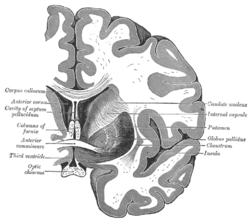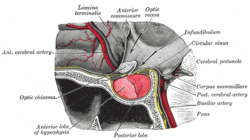- Anterior commissure
-
Brain: Anterior commissure 
Coronal section of brain through anterior commissure. (Label for "anterior commissure" is on left, third from bottom.) 
The hypophysis cerebri in position. Shown in sagittal section. (Caption for anterior commissure is at center top.) Latin commissura anterior Gray's subject #189 840 NeuroNames hier-187 NeuroLex ID birnlex_1557 The anterior commissure (also known as the precommissure) is a bundle of nerve fibers (white matter), connecting the two cerebral hemispheres across the midline, and placed in front of the columns of the fornix. The great majority of fibers connecting the two hemispheres travel through the corpus callosum, which is over 10 times larger than the anterior commissure, and other routes of communication pass through the hippocampal commissure or, indirectly, via subcortical connections. Nevertheless, the anterior commissure is a significant pathway that can be clearly distinguished in the brains of all mammals.
In a sagittal section, the anterior commissure is oval in shape, having a long vertical axis that measures about 5 mm.
Contents
Connections
The fibers of the anterior commissure can be traced laterally and posteriorly on either side beneath the corpus striatum into the substance of the temporal lobe.
It serves in this way to connect the two temporal lobes, but it also contains decussating fibers from the olfactory tracts, and is a part of the neospinothalamic tract for pain. The anterior commissure also serves to connect the two amygdala.
Sexuality
In a 1991 brain study performed by Laura Allen and Roger Gorski of UCLA observed that there was size differences of the brain's anterior commissure between a group of heterosexual men and a group of women and homosexual men. But as William Brye and Bruce Parson's point out, this study has "many of the same interpretive difficulties as LeVay's." These include a "tremendous" number of exceptions, such as the fact that 27 of 30 homosexual men had anterior commissures that "fell within the range established by 30 heterosexual men." [1] These studies were motivated by the idea that the male homosexual brain is more similar to a female brain in function than the brain of a heterosexual male would be, and hence would express less lateralisation and greater cross-talk between hemispheres.
See also
References
- ^ L.S. Allen and R.A. Gorski, "Sexual Orientation and the size of the anterior commissure in the human brain," Proc. Natl. Acad. Sci. 89 (1992): pp. 7199-7202, cited in Byne and Parsons, op. cit. p. 235.
Additional images
External links
- Overview at University of Cambridge
- Roche Lexicon - illustrated navigator, at Elsevier 13048.000-3
- http://www2.umdnj.edu/~neuro/studyaid/Practical2000/Q09.htm
- Sexual orientation and the size of the anterior commissure in the human brain
- NIF Search - Anterior Commissure via the Neuroscience Information Framework
This article was originally based on an entry from a public domain edition of Gray's Anatomy. As such, some of the information contained within it may be outdated.
Human brain, cerebrum, Interior of the cerebral hemispheres, white matter: commissural fibers and septum (TA A14.1.09.241–271, 569–571, GA 9.828, 838–840) Corpus callosum Lamina terminalis Fornix Septum pellucidum Categories:- Cerebrum
- Neuroscience stubs
Wikimedia Foundation. 2010.





